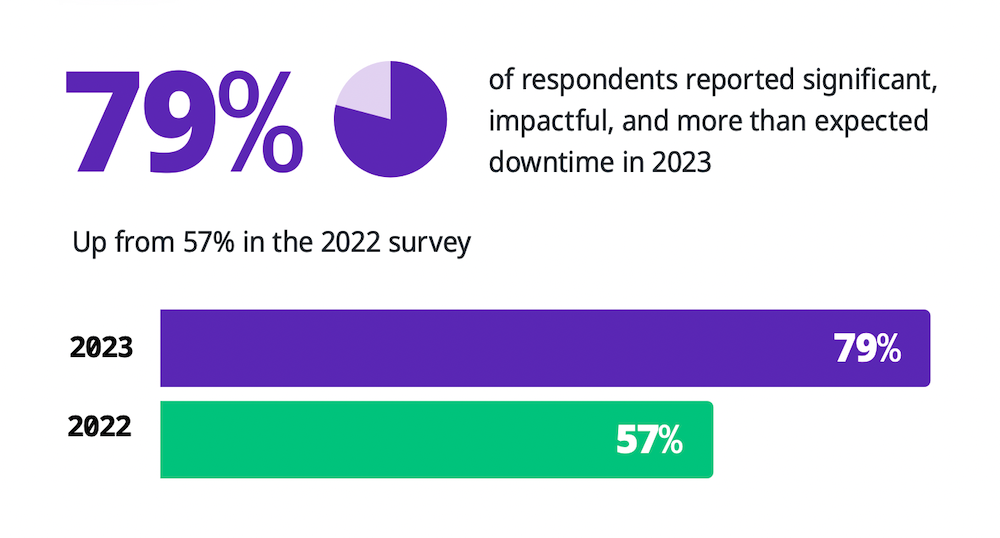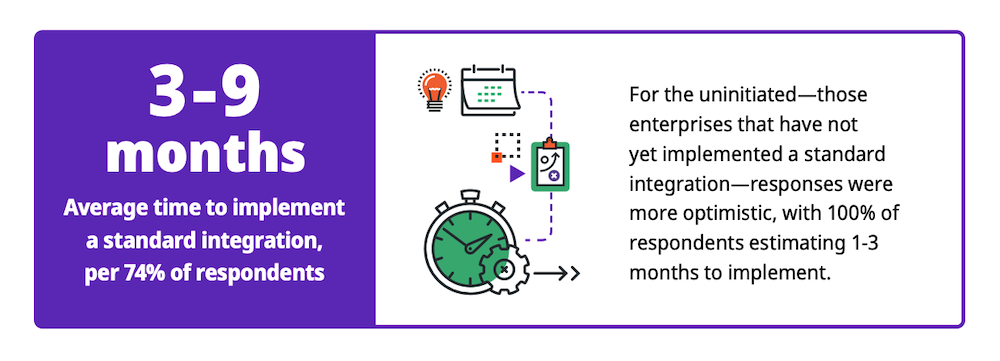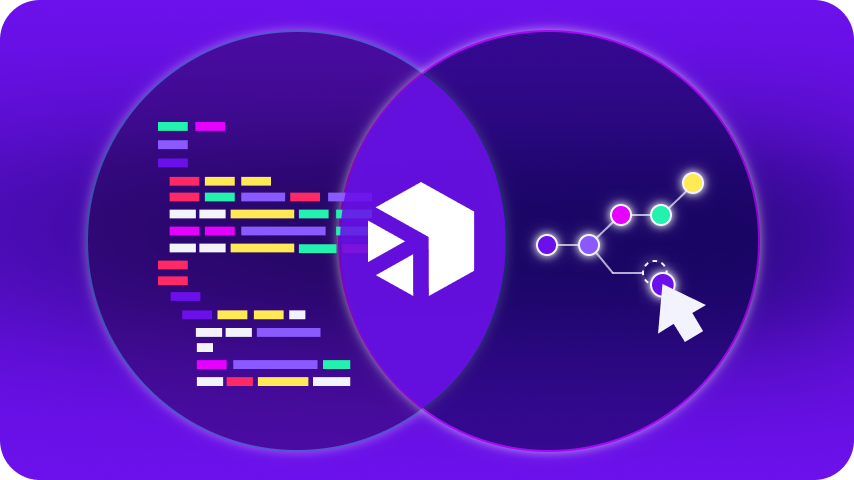May 9, 2023
In 2023, Digibee conducted our second annual State of Enterprise Integration survey, reaching out to one thousand CTOs, CIOs, system architects, and web developers in North America.
In each blog post in this series, we examine a top finding in the report, as identified by your peers. Today we dig deep on the impact of system downtime when implementing an integration platform.
The Challenge: System Downtime
What’s worse than dealing with the digital transformation challenges of legacy systems, changing priorities, inter-departmental communication issues, and inadequate resources? System downtime.

In Digibee’s 2023 State of Enterprise Integration Report our respondents reported a steep increase in system downtime that was significant, impactful, and more than expected when compared to the 2022 survey data. Many IT issues contribute to the length and severity of a system’s downtime, from reliance on outdated integration technology that may be run in-house, on-premises, or using legacy systems, to a lack of monitoring or a slow and inefficient deployment process.
 When Systems Go Down… Costs Go Up
When Systems Go Down… Costs Go Up
Successful digital transformation hinges on building a system that is just as reliable as it is fast. Each time a system experiences downtime, the business experiences a significant financial impact. In this way an unreliable integration can end up costing the business more money than it saves through other efficiencies.
The cost of downtime has increased significantly for 90% of SME and large enterprises, with 44% reporting that a single hour of downtime could potentially cost over $1M.
– Information Technology Intelligence Consulting, Hourly Cost of Downtime, 2022
The financial cost can take on many forms, during the integration process and after the new integration has been deployed, including:
Bloated Integration Timelines
At the outset of integration a common business goal is to accelerate digital transformation as much as possible. When asked how long they believed their integration would take, our 2023 State of Enterprise Integration Report found that those just beginning their integration journey estimated 1-3 months. In contrast, those who had completed a standard integration reported it took 3-9 months; a 300% increase! That’s a serious degradation of optimism for those who have seemingly learned the hard way.
While IT downtime is not the singular root cause of timeline disparity, the downtime that occurs during the implementation phase can easily become a main contributor to eroding timelines, especially with an inexperienced (or understaffed) in-house team. This happens through complicating the vital feedback loop of testing integrations as developers are forced to search for the source of each failure and correct it.
And remember, where integration timelines extend, costs expand for the rest of the business as well. At a minimum the business must retain its old inefficient system longer. Worst-case-scenario: IT downtime impacts core business systems too.
How long does it take your team to implement a standard integration?
Inability to Conduct Business Transactions
Once your integration is live, you might feel like your integration journey is over. Unfortunately, performance issues crop up once deployed in the real world when integrations (and every service they connect to) must scale to accommodate peak times. Of course if your original integration development testing also resulted in a patchwork of fixes, those patches will remain as weak points in the system.
It doesn’t require much imagination to picture how system downtime from live integrations cost a business money: by preventing customers from accessing services or products. For example, if a POS system integration with a payment provider goes down, your customer now has to have cash on-hand or they can’t buy your goods or services. If your outage is with your ecommerce platform, your customer may be left with zero options to buy.
The only thing that keeps going is your overhead, with sales people sitting idle, inventory stalled, and your operating expenses continuing to accrue.
Customer Satisfaction and Reputation
Your ability to satisfy your customers represents a distinctly different but equally costly problem: a hit to your professional reputation means an incalculable loss in future sales.
Whether you are a service provider whose IT downtime just took down your client’s website (also… hello SLA penalties!), or a retailer who left a customer in the lurch, customers are unlikely to stick around if your business isn’t delivering a positive and beneficial experience. And just like happy customers, unhappy customers tell their friends.
Successful Digital Transformation with iPaaS
3 Benefits of Using Digibee’s iPaaS for Your Digital Transformation
Whether rebuilding previous integrations or starting from scratch, iPaaS factors heavily into your digital transformation journey. A successful strategy is well-thought-out, minimizing system downtime, and providing contingency plans for unexpected outages during integration, deployment, and beyond. Digibee’s iPaaS is an invaluable part of the plan, providing expertise and resiliency throughout:
1. Accelerating System Integrations
Digibee mitigates the risk of system downtime during integration implementation by accelerating digital transformation, keeping the transition period short and well-defined. Harnessing Digibee’s reusable capsules makes it easy to leverage out-of-the-box solutions or to modify them as needed.
The technology is faster and much less error-prone versus building every integration from scratch, and the IT learning curve is minimal with Digibee’s supportive 3-Step Customer Onboarding.
2. Reducing Downtime During Integration Deployment
Downtime often occurs during implementation, disrupting the business and exposing customers to a negative experience.
Digibee’s iPaaS minimizes–and often eliminates–downtime, running the new system in tandem with the legacy system for a seamless switchover. Our platform manages development, testing, and production environments through DevOps, and includes a fully automated pipeline deployment and publication process. This concurrency removes the risk and worry when it’s time to flip the switch.
3. IT Maintenance and Preventative Measures
Once the integration is up and running, Digibee’s iPaaS keeps things running smoothly. Each pipeline in the implementation is completely isolated within a Kubernetes infrastructure, optimized for each specific use case. Failure of one pipeline doesn’t affect the execution of another, and a new instance can be started in under a second — drastically reducing system downtime and other IT issues.
Valuable preventive measures such as configurable security systems, 24×7 monitoring, and streamlined error handling enable the business to react immediately to the first sign of trouble before disruptions can occur.
With so many challenges to overcome, it’s no surprise that over 70% of leaders surveyed are actively planning to adopt, supplement, or replace their integration technology in 2023.
Learn How Digibee Can help
Get the full story on what’s changed and how your peers are mobilizing enterprise integration in 2023. Download your free Digibee 2023 State of Enterprise Integration report today for all of the survey results and the analysis.













